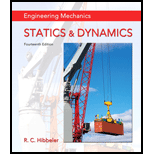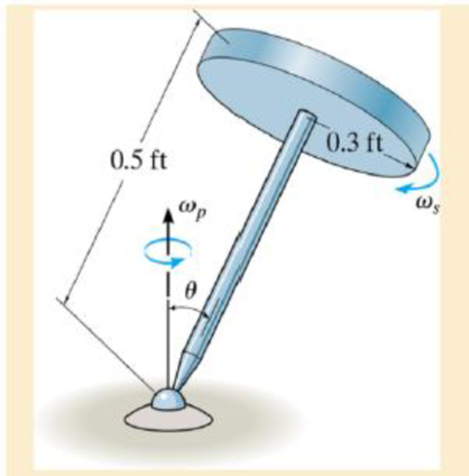
Engineering Mechanics: Statics & Dynamics (14th Edition)
14th Edition
ISBN: 9780133915426
Author: Russell C. Hibbeler
Publisher: PEARSON
expand_more
expand_more
format_list_bulleted
Concept explainers
Textbook Question
Chapter 21.6, Problem 65P
Solve Prob. 21–64 when θ =90º.

Expert Solution & Answer
Want to see the full answer?
Check out a sample textbook solution
Students have asked these similar questions
Complete the following problems. Show your work/calculations, save as.pdf and upload to the
assignment in Blackboard.
1. What are the x and y dimensions for the center position of holes 1,2, and 3 in the part shown in
Figure 26.2 (below)?
6.0000
7118
Zero
reference
point
1.0005
1.0000
1.252
Bore
C' bore
1.250
6.0000
.7118
0.2180 deep
(3 holes)
2.6563 1.9445
3.000 diam. slot
0.3000 deep.
0.3000 wide
2.6563
1.9445
Complete the following problems. Show your work/calculations, save as.pdf and upload to the
assignment in Blackboard.
missing information to present a completed program. (Hint: You may have to look up geometry
for the center drill and standard 0.5000 in twist drill to know the required depth to drill).
1. What are the x and y dimensions for the center position of holes 1,2, and 3 in the part shown in
Figure 26.2 (below)?
6.0000
Zero
reference
point
7118
1.0005
1.0000
1.252
Bore
6.0000
.7118
Cbore
0.2180 deep
(3 holes)
2.6563 1.9445
Figure 26.2
026022 (8lot and Drill Part)
(Setup Instructions---
(UNITS: Inches
(WORKPIECE NAT'L SAE 1020 STEEL
(Workpiece: 3.25 x 2.00 x0.75 in. Plate
(PRZ Location 054:
'
XY 0.0 - Upper Left of Fixture
TOP OF PART 2-0
(Tool List
( T02 0.500 IN 4 FLUTE FLAT END MILL
#4 CENTER DRILL
Dashed line indicates-
corner of original stock
( T04
T02
3.000 diam. slot
0.3000 deep.
0.3000 wide
Intended toolpath-tangent-
arc entry and exit sized to
programmer's judgment…
A program to make the part depicted in Figure 26.A has been created, presented in figure 26.B, but some information still needs to be filled in. Compute the tool locations, depths, and other missing information to present a completed program. (Hint: You may have to look up geometry for the center drill and standard 0.5000 in twist drill to know the required depth to drill).
Chapter 21 Solutions
Engineering Mechanics: Statics & Dynamics (14th Edition)
Ch. 21.1 - Show that the sum of the moments of inertia of a...Ch. 21.1 - Prob. 2PCh. 21.1 - Prob. 3PCh. 21.1 - Determine the moments of inertia Ix and Iy of the...Ch. 21.1 - Prob. 5PCh. 21.1 - Determine by direct integration the product of...Ch. 21.1 - Prob. 7PCh. 21.1 - Prob. 8PCh. 21.1 - Prob. 9PCh. 21.1 - Prob. 10P
Ch. 21.1 - Prob. 11PCh. 21.1 - Determine the moment of inertia Ixx of the...Ch. 21.1 - Prob. 13PCh. 21.1 - Prob. 14PCh. 21.1 - Prob. 15PCh. 21.1 - Prob. 16PCh. 21.1 - The bent rod has a weight of 1.5 lb/ft. Locate the...Ch. 21.1 - Prob. 18PCh. 21.1 - Prob. 19PCh. 21.1 - Prob. 20PCh. 21.1 - Prob. 21PCh. 21.3 - If a body contains no planes of symmetry, the...Ch. 21.3 - Prob. 23PCh. 21.3 - The 15-kg circular disk spins about its axle with...Ch. 21.3 - Prob. 25PCh. 21.3 - Prob. 26PCh. 21.3 - Prob. 27PCh. 21.3 - Prob. 28PCh. 21.3 - Prob. 29PCh. 21.3 - Prob. 30PCh. 21.3 - Prob. 31PCh. 21.3 - The 2-kg thin disk is connected to the slender rod...Ch. 21.3 - Prob. 33PCh. 21.3 - Prob. 34PCh. 21.3 - The 200-kg satellite has its center of mass at...Ch. 21.3 - Prob. 36PCh. 21.3 - Prob. 37PCh. 21.3 - Determine the kinetic energy of the 7-kg disk and...Ch. 21.3 - Prob. 39PCh. 21.3 - Prob. 40PCh. 21.4 - Prob. 41PCh. 21.4 - Prob. 42PCh. 21.4 - Prob. 43PCh. 21.4 - Prob. 44PCh. 21.4 - Prob. 45PCh. 21.4 - The assembly is supported by journal bearings at A...Ch. 21.4 - Prob. 47PCh. 21.4 - Prob. 48PCh. 21.4 - Prob. 49PCh. 21.4 - Prob. 50PCh. 21.4 - Prob. 51PCh. 21.4 - Prob. 52PCh. 21.4 - Prob. 53PCh. 21.4 - Prob. 54PCh. 21.4 - Prob. 55PCh. 21.4 - Prob. 56PCh. 21.4 - The blades of a wind turbine spin about the shaft...Ch. 21.4 - Prob. 58PCh. 21.4 - The thin rod has a mass of 0.8 kg and a total...Ch. 21.4 - Show that the angular velocity of a body, in terms...Ch. 21.4 - A thin rod is initially coincident with the Z axis...Ch. 21.6 - The gyroscope consists of a uniform 450-g disk D...Ch. 21.6 - The toy gyroscope consists of a rotor R which is...Ch. 21.6 - The top consists of a thin disk that has a weight...Ch. 21.6 - Solve Prob. 2164 when =90.Ch. 21.6 - Prob. 66PCh. 21.6 - Prob. 67PCh. 21.6 - Prob. 68PCh. 21.6 - Prob. 69PCh. 21.6 - Prob. 70PCh. 21.6 - Prob. 71PCh. 21.6 - Prob. 72PCh. 21.6 - Prob. 73PCh. 21.6 - Prob. 74PCh. 21.6 - Prob. 75PCh. 21.6 - Prob. 76PCh. 21.6 - Prob. 77PCh. 21.6 - Prob. 78P
Knowledge Booster
Learn more about
Need a deep-dive on the concept behind this application? Look no further. Learn more about this topic, mechanical-engineering and related others by exploring similar questions and additional content below.Similar questions
- We consider a laminar flow induced by an impulsively started infinite flat plate. The y-axis is normal to the plate. The x- and z-axes form a plane parallel to the plate. The plate is defined by y = 0. For time t <0, the plate and the flow are at rest. For t≥0, the velocity of the plate is parallel to the 2-coordinate; its value is constant and equal to uw. At infinity, the flow is at rest. The flow induced by the motion of the plate is independent of z. (a) From the continuity equation, show that v=0 everywhere in the flow and the resulting momentum equation is მu Ət Note that this equation has the form of a diffusion equation (the same form as the heat equation). (b) We introduce the new variables T, Y and U such that T=kt, Y=k/2y, U = u where k is an arbitrary constant. In the new system of variables, the solution is U(Y,T). The solution U(Y,T) is expressed by a function of Y and T and the solution u(y, t) is expressed by a function of y and t. Show that the functions are identical.…arrow_forwardPart A: Suppose you wanted to drill a 1.5 in diameter hole through a piece of 1020 cold-rolled steel that is 2 in thick, using an HSS twist drill. What values if feed and cutting speed will you specify, along with an appropriate allowance? Part B: How much time will be required to drill the hole in the previous problem using the HSS drill?arrow_forward1.1 m 1.3 m B 60-mm diameter Brass 40-mm diameter Aluminum PROBLEM 2.52 - A rod consisting of two cylindrical portions AB and BC is restrained at both ends. Portion AB is made of brass (E₁ = 105 GPa, α = 20.9×10°/°C) and portion BC is made of aluminum (Ę₁ =72 GPa, α = 23.9×10/°C). Knowing that the rod is initially unstressed, determine (a) the normal stresses induced in portions AB and BC by a temperature rise of 42°C, (b) the corresponding deflection of point B.arrow_forward
- 30 mm D = 40 MPa -30 mm B C 80 MPa PROBLEM 2.69 A 30-mm square was scribed on the side of a large steel pressure vessel. After pressurization, the biaxial stress condition at the square is as shown. For E = 200 GPa and v=0.30, determine the change in length of (a) side AB, (b) side BC, (c) diagnonal AC.arrow_forwardPlease solve in detail this problem thank youarrow_forward0,5 mm 450 mm 350 mm Bronze A = 1500 mm² E = 105 GPa प 21.6 × 10-PC Aluminum A = 1800 mm² £ = 73 GPa = a 23.2 × 10-PC PROBLEM 2.58 Knowing that a 0.5-mm gap exists when the temperature is 24°C, determine (a) the temperature at which the normal stress in the aluminum bar will be equal to -75 MPa, (b) the corresponding exact length of the aluminum bar.arrow_forward
- 0.5 mm 450 mm -350 mm Bronze Aluminum A 1500 mm² A 1800 mm² E 105 GPa E 73 GPa K = 21.6 X 10 G < = 23.2 × 10-G PROBLEM 2.59 Determine (a) the compressive force in the bars shown after a temperature rise of 82°C, (b) the corresponding change in length of the bronze bar.arrow_forwardThe truss shown below sits on a roller at A and a pin at E. Determine the magnitudes of the forces in truss members GH, GB, BC and GC. State whether they are in tension or compression or are zero force members.arrow_forwardA weight (W) hangs from a pulley at B that is part of a support frame. Calculate the maximum possible mass of the weight if the maximum permissible moment reaction at the fixed support is 100 Nm. Note that a frictionless pin in a slot is located at C.arrow_forward
- It is the middle of a winter snowstorm. Sally and Jin take shelter under an overhang. The loading of the snow on top of the overhang is shown in the figure below. The overhang is attached to the wall at points A and B with pin supports. Another pin is at C. Determine the reactions of the pin supports at A and B. Express them in Cartesian vector form.arrow_forwardRecall that the CWH equation involves two important assumptions. Let us investigate how these assumptions affect the accuracy of state trajectories under the control inputs optimized in (a) and (b). (c.1): Discuss the assumptions about the chief and deputy orbits that are necessary for deriving CWH.arrow_forwardPROBLEM 2.50 1.8 m The concrete post (E-25 GPa and a = 9.9 x 10°/°C) is reinforced with six steel bars, each of 22-mm diameter (E, = 200 GPa and a, = 11.7 x 10°/°C). Determine the normal stresses induced in the steel and in the concrete by a temperature rise of 35°C. 6c " 0.391 MPa 240 mm 240 mm 6₁ = -9.47 MPaarrow_forward
arrow_back_ios
SEE MORE QUESTIONS
arrow_forward_ios
Recommended textbooks for you
 International Edition---engineering Mechanics: St...Mechanical EngineeringISBN:9781305501607Author:Andrew Pytel And Jaan KiusalaasPublisher:CENGAGE L
International Edition---engineering Mechanics: St...Mechanical EngineeringISBN:9781305501607Author:Andrew Pytel And Jaan KiusalaasPublisher:CENGAGE L

International Edition---engineering Mechanics: St...
Mechanical Engineering
ISBN:9781305501607
Author:Andrew Pytel And Jaan Kiusalaas
Publisher:CENGAGE L
Solids: Lesson 53 - Slope and Deflection of Beams Intro; Author: Jeff Hanson;https://www.youtube.com/watch?v=I7lTq68JRmY;License: Standard YouTube License, CC-BY